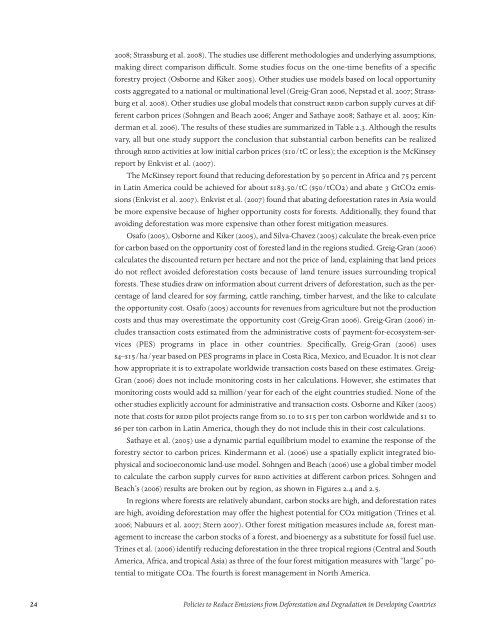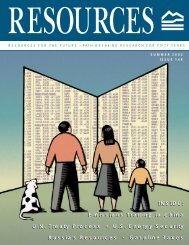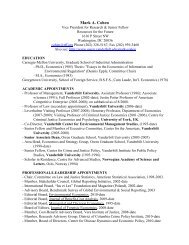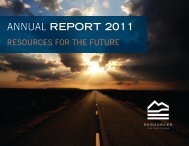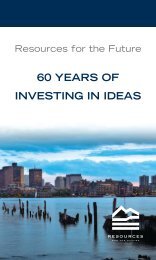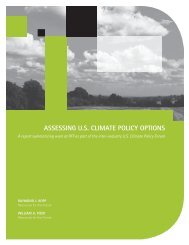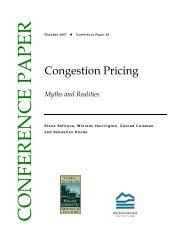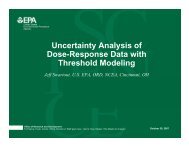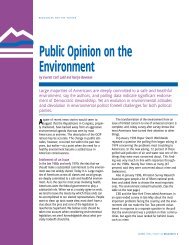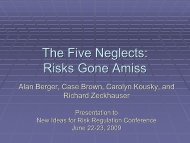Policies to Reduce Emissions from Deforestation and Degradation ...
Policies to Reduce Emissions from Deforestation and Degradation ...
Policies to Reduce Emissions from Deforestation and Degradation ...
Create successful ePaper yourself
Turn your PDF publications into a flip-book with our unique Google optimized e-Paper software.
2008; Strassburg et al. 2008). The studies use different methodologies <strong>and</strong> underlying assumptions,<br />
making direct comparison difficult. Some studies focus on the one-time benefits of a specific<br />
forestry project (Osborne <strong>and</strong> Kiker 2005). Other studies use models based on local opportunity<br />
costs aggregated <strong>to</strong> a national or multinational level (Greig-Gran 2006, Nepstad et al. 2007; Strassburg<br />
et al. 2008). Other studies use global models that construct REDD carbon supply curves at different<br />
carbon prices (Sohngen <strong>and</strong> Beach 2006; Anger <strong>and</strong> Sathaye 2008; Sathaye et al. 2005; Kinderman<br />
et al. 2006). The results of these studies are summarized in Table 2.3. Although the results<br />
vary, all but one study support the conclusion that substantial carbon benefits can be realized<br />
through REDD activities at low initial carbon prices ($10/tC or less); the exception is the McKinsey<br />
report by Enkvist et al. (2007).<br />
The McKinsey report found that reducing deforestation by 50 percent in Africa <strong>and</strong> 75 percent<br />
in Latin America could be achieved for about $183.50/tC ($50/tCO2) <strong>and</strong> abate 3 GtCO2 emissions<br />
(Enkvist et al. 2007). Enkvist et al. (2007) found that abating deforestation rates in Asia would<br />
be more expensive because of higher opportunity costs for forests. Additionally, they found that<br />
avoiding deforestation was more expensive than other forest mitigation measures.<br />
Osafo (2005), Osborne <strong>and</strong> Kiker (2005), <strong>and</strong> Silva-Chavez (2005) calculate the break-even price<br />
for carbon based on the opportunity cost of forested l<strong>and</strong> in the regions studied. Greig-Gran (2006)<br />
calculates the discounted return per hectare <strong>and</strong> not the price of l<strong>and</strong>, explaining that l<strong>and</strong> prices<br />
do not reflect avoided deforestation costs because of l<strong>and</strong> tenure issues surrounding tropical<br />
forests. These studies draw on information about current drivers of deforestation, such as the percentage<br />
of l<strong>and</strong> cleared for soy farming, cattle ranching, timber harvest, <strong>and</strong> the like <strong>to</strong> calculate<br />
the opportunity cost. Osafo (2005) accounts for revenues <strong>from</strong> agriculture but not the production<br />
costs <strong>and</strong> thus may overestimate the opportunity cost (Greig-Gran 2006). Greig-Gran (2006) includes<br />
transaction costs estimated <strong>from</strong> the administrative costs of payment-for-ecosystem-services<br />
(PES) programs in place in other countries. Specifically, Greig-Gran (2006) uses<br />
$4–$15/ha/year based on PES programs in place in Costa Rica, Mexico, <strong>and</strong> Ecuador. It is not clear<br />
how appropriate it is <strong>to</strong> extrapolate worldwide transaction costs based on these estimates. Greig-<br />
Gran (2006) does not include moni<strong>to</strong>ring costs in her calculations. However, she estimates that<br />
moni<strong>to</strong>ring costs would add $2 million/year for each of the eight countries studied. None of the<br />
other studies explicitly account for administrative <strong>and</strong> transaction costs. Osborne <strong>and</strong> Kiker (2005)<br />
note that costs for REDD pilot projects range <strong>from</strong> $0.10 <strong>to</strong> $15 per <strong>to</strong>n carbon worldwide <strong>and</strong> $1 <strong>to</strong><br />
$6 per <strong>to</strong>n carbon in Latin America, though they do not include this in their cost calculations.<br />
Sathaye et al. (2005) use a dynamic partial equilibrium model <strong>to</strong> examine the response of the<br />
forestry sec<strong>to</strong>r <strong>to</strong> carbon prices. Kindermann et al. (2006) use a spatially explicit integrated biophysical<br />
<strong>and</strong> socioeconomic l<strong>and</strong>-use model. Sohngen <strong>and</strong> Beach (2006) use a global timber model<br />
<strong>to</strong> calculate the carbon supply curves for REDD activities at different carbon prices. Sohngen <strong>and</strong><br />
Beach’s (2006) results are broken out by region, as shown in Figures 2.4 <strong>and</strong> 2.5.<br />
In regions where forests are relatively abundant, carbon s<strong>to</strong>cks are high, <strong>and</strong> deforestation rates<br />
are high, avoiding deforestation may offer the highest potential for CO2 mitigation (Trines et al.<br />
2006; Nabuurs et al. 2007; Stern 2007). Other forest mitigation measures include AR, forest management<br />
<strong>to</strong> increase the carbon s<strong>to</strong>cks of a forest, <strong>and</strong> bioenergy as a substitute for fossil fuel use.<br />
Trines et al. (2006) identify reducing deforestation in the three tropical regions (Central <strong>and</strong> South<br />
America, Africa, <strong>and</strong> tropical Asia) as three of the four forest mitigation measures with “large” potential<br />
<strong>to</strong> mitigate CO2. The fourth is forest management in North America.<br />
24 <strong>Policies</strong> <strong>to</strong> <strong>Reduce</strong> <strong>Emissions</strong> <strong>from</strong> <strong>Deforestation</strong> <strong>and</strong> <strong>Degradation</strong> in Developing Countries


